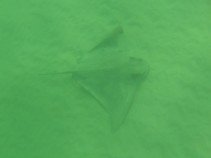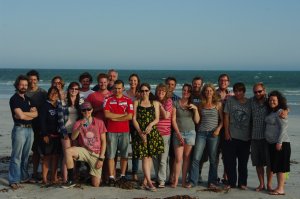By Daniel Petraccaro, Master of Maritime Archaeology Student (Flinders University)
Introduction
The maritime archaeology fieldwork on Hinchinbrook Island (figure one) was conducted by the Queensland Department of Environment and Heritage Protection (DEHP) with the grateful support of the Hinchinbrook National Park. The aim was to locate, identify and record the maritime heritage sites on and around Hinchinbrook Island. This blog will discuss two sites investigated: The wreck of Belle in Ramsay Bay (figure one; figure two) and a nearby concentration of possible ships’ fittings to the south of Belle. Masters students and staff from the Flinders University Archaeology Department were lucky enough to assist DEHP with the recording and interpretation of maritime archaeological sites on the island.

Figure One: Map of Hinchinbrook Island and Location of Belle in Ramsey Bay. Google Earth.

Figure two: Belle after Cyclone Yasi in 2011. http://www.townsvillebulletin.com.au/article/2011/09/03/263161_news.html. Accessed 25/07/13.
Using the archaeological results of the fieldwork, I will discuss in this blog how the sites investigated at Ramsey Bay are interconnected within the concept of a maritime cultural landscape. I will also hopefully show how human behaviour and the natural landscape play a part in the maritime setting. The maritime cultural landscape signifies human utilisation (economy) of maritime space: boats, settlement, fishing, hunting and shipping (Westerdahl 1992: 5).
Background: Hinchinbrook Island
Hinchinbrook Island is the perfect tropical paradise. The island is part of the Great Barrier Reef Marine Park and protected within the Hinchinbrook Island National Park. Hinchinbrook Island is eight kilometres east from the Queensland coast at Cardwell (figure three). Spectacular natural vegetation includes mangroves, scrublands and tropical rainforests. Sandy isolated beaches and the view from the prestige coastline are breathtaking! If you are interesting in visiting the island, the only way to access Hinchinbrook Island is using shipping transport launched from Cardwell or Lucinda; if you are prone to seasickness, I suggest you bring some medication along!
![DSCN7766[1]](../../2013/07/dscn77661_w-300-h-225.jpg)
Figure three: Sunrise at Cardwell. Hinchinbrook Island in the distance. Photo courtesy of Daniel Petraccaro
Historical Background: Hinchinbrook Island
I found most of the historical research on Hinchinbrook Island in Douglass Barrie’s book: Minding My Business; an interesting read. Hinchinbrook Island contains natural resources extracted by European Australians from the 1850s until the early 1930s. Cedar oak, a valuable hardy timber, was logged during the 1850s (Barrie 2003: 120). Shell middens were also mined during the 1860s and processed into lime (Barrie 2003: 121). The lack of jetty structures, the isolated conditions of the island, and shallow bays (figure four) made for difficult access, which in turn prevented the further development of these industries. Sugar plantations were also established on the island during the late 1800s but were abandoned due to seasonal cyclone damage and gale force winds (Barrie 2003: 121 – 123).
![DSCN7770[1]](../../2013/07/dscn77701_w-300-h-225.jpg)
Figure four: Flat tidal zone ( tide is out) at Ramsey Bay. Photo courtesy of Daniel Petraccaro
The Hinchinbrook Channel was also an important shipping route from the 1850s until the early 1900s (Barrie 2003: 114, 117, 124). The 22 kilometre channel separates the mainland from the island (figure one). The channel was an important trading route for vessels shipping cedar from the great forests in Cairns and Atherton to Melbourne and Sydney (North Queensland Register 1900: 31). The Hinchinbrook Channel was also an important route, as much of the surrounding Great Barrier Reef was uncharted and exposed by strong winds and waves.
The Shipwreck Sequence at Ramsey Bay, Hinchinbrook Island
Ramsey Bay was of interest to this field study due to historical accounts of four ships known to have wrecked while attempting to retrieve a cargo of cedar washed up on shore after the Merchant wrecked on the 5th March 1878 (North Queensland Register 1900: 31). Merchant was a steamer built in the USA in 1862. While Merchant was en route to Melbourne from Port Douglas, the ship hit a reef and vanished. The exact wreckage location of Merchant was never found. Once reports reached Cardwell of the cedar logs washing up in Ramsey Bay, the Harriet Armitage (Barque) was sent to retrieve the cargo (North Queensland Register: 1900: 31). The cedar was considered more valuable than the lives sent on the salvage mission (Barrie 2003: 111). Despite the efforts of Harriet Armitage, gale winds in Ramsey Bay caused the ship to run ashore and wreck in July 1879. Three other ships followed Harriet Armitage, unfortunately, strong gales caused all three ships to wreck in Ramsey Bay. Charlotte Andrews (Barque) wrecked in October 1879, Rebecca Jane (Brigantine) wrecked in July 1880 and Belle (figure two; figure five) (Brigantine) wrecked in February 1880 (Morning Bulletin 1925: 5). The cedar was eventually salvaged by a fifth shipping vessel and sold at auction in Townsville (Morning Bulletin 1925: 5).
The Natural Landscape at Ramsey Bay, Hinchinbrook Island
The natural landscape played a crucial role in the wreckage sequence and process at Ramsey Bay. While Merchant struck a reef hundreds of kilometres away, winds and strong surf caused the cargo to drift until it finally beached at Ramsey Bay. One survivor from the Harriet Armitage noted the tremendous surf on the beach and claimed the wind and sea rose extremely rapidly (North Queensland Register 1900: 31). Without any jetty infrastructures, the shallow waters also proved to be a difficult task for ships trying to reach Ramsey Bay, the only logical access point for the vessels trying to retrieve cargo washed onto shore. Ramsey Bay is naturally encompassed by mangrove forests to the north-east and south (figure one; figure five), which is impossible to travel through by foot or sailing vessel.

Figure five: Ramsey Bay showing the location of Belle and southern artefact concentration. Google Earth.
The Maritime Cultural Landscape at Ramsey Bay
You would be surprised to hear of the amount of rubbish washed up on Ramsey Bay. The dunes were littered with bottles, plastic, iron drums, wood and the largest variety of thongs I have ever seen. While one might only see rubbish, I saw a landscape and a deposition event that has occurred within the bay for the past 150 years. It was an interesting task rummaging through the rubbish hoping to find the remains of a wreck! No luck, however. Similar to how the rubbish had washed up on shore, it is easy to forget the cargo of cedar timber followed the same pattern when it washed up in Ramsey Bay in 1878.
It is also interesting to note that Cyclone Yasi in 2011 (figure six) drastically altered the maritime landscape. The cyclone caused a drastic change in the sand dune, exposing the wreckage of Belle (figure two) (Waterson 2012) and a site called ‘Southern Artefact Concentration’, located eight-hundred and fifty meters south from Belle. However, during the current fieldwork, shifting dune sands had covered most of Belle and the remains of ‘Southern Artefact Concentration’ under a minimum of 10 cm of sand, suggesting the sand dune has recovered since the cyclone two years ago. The remains of Belle identified during previous surveys include the frames, metal brackets and windlass (Waterson 2012). Iron cable was also identified west of the ship’s bow. During the current fieldwork, the remains of iron bolts, rods and mast caps (courtesy of Paddy Waterson who helped with the identification) (figure seven; figure eight) were identified within the upper tidal zone and sand dune at ‘Southern Artefact Concentration.’

Figure six: Path of cyclone Yasi in 2011. bom.gov.com.au. Accessed 25/07/13.
Discussion: The Maritime Landscape at Ramsey Bay, Hinchinbrook Island
The results of both Belle and the ‘Southern Artefact Concentration’ suggest there is evidence of interaction between the sea and the wreckage history of shipping vessels at Ramsey Bay. The identification of Belle within the tidal zone at Ramsey Bay supports the theory that strong winds and surf caused the ship to wreck. One newspaper article states that Belle, when fully loaded, parted her cables and drifted ‘whole’ onto the beach (Morning Bulletin 1925: 5). The location of the cables east of Belle were identified during the study and therefore conform to the historical accounts regarding how the ship wrecked. Furthermore, the lack of any remains from Belle conforms to historical accounts that the cargo was eventually salvaged. The mast caps identified from ‘Southern Artefact Concentration’ are from either Belle or another wreck (figure seven; figure eight). The results support the theory that remains such as wood and other cargo was salvaged, while the mast caps and another other iron items were left behind.

Figure seven: (LEFT) Mast Caps from ‘Southern Artefact Concentration’. Photo Courtesy of Paddy Waterson.
Figure eight: (RIGHT): Mast caps. (Paasch 1890: plate 93).
The natural landscape could aid in identifying the possible location of the other known wrecks in Ramsey Bay. Belle was known to have wrecked during strong gale winds so there is no surprise the ship ended up stranded in the tidal zone (figure five). The three other wrecks known to have wrecked in Ramsey Bay are also most likely to be located in the tidal zone. The three other ships all were wrecked during strong winds while trying to salvage timber. They are most likely to be located within the same vicinity as Belle. These wrecks are also likely to be salvaged and therefore few archaeological remains would be present.
Summary: The Cultural Maritime Landscape of Ramsey Bay
The sea and the maritime cultural landscape of Hinchinbrook Island have influenced the economic development and wrecking process of shiping vessels at Ramsey Bay. Merchant wrecked while attempting to travel from Cairns to Melbourne following charted trading routes and the Hinchinbrook Channel. It is clear that the sites and shipwrecks identified at Ramsey Bay have resulted from salvage events, commencing with the cedar timber cargo from Merchant. The only way to salvage cargo at Ramsey Bay is via ship. However, the shallow coastline, gale winds and tides at Ramsey Bay caused the wreckage of four ships. The cedar and the shipwrecks were eventually salvaged. Items with little monetary value, such as iron, were left behind. Therefore, when examining a maritime landscape, it is important to include all factors relating to, and influencing, the maritime activity within an area. Overall, this type of archaeological investigation shows how human behaviour and natural landscapes play an important part in the maritime setting. In summary, I hope you have all learnt something about the cultural maritime landscape history of Ramsey Bay!
Acknowledgements
A special thanks to the Department of Environment and Heritage Protection (DEHP) for allowing the Flinders students to participate in the fieldwork, and, the Hinchinbrook National Park for granting access. A warm thanks goes out to Paddy Waterson (DEHP), Amelia Lacey (DEHP) and Ed Slaughter (Queensland Museum).
References
Barrie, Douglas 2003. Minding my Business: The History of Bemerside and the Lower Herbert River District of North Queensland Australia. S and D Barrie, Ingham, Queensland.
Morning Bulletin 1929. http://trove.nla.gov.au/ndp/del/article/54641887. Accessed 22/07/2013.
North Queensland Register 1900. http://trove.nla.gov.au/ndp/del/article/82342975. Accessed 22/07/2013.
Paasch, Hermann 1890. Illustrated Marine Encyclopedia. Argus Books, England.
Waterson, Paddy 2012. Shipwreck Heritage: The Belle. Unpublished powerpoint report. QEHP, Queensland.
Westerdahl, Christer 1992. The maritime cultural landscape. The International Journal of Nautical Archaeology 21(1):5-14.

















![DSCN7766[1]](../../2013/07/dscn77661_w-300-h-225.jpg)
![DSCN7770[1]](../../2013/07/dscn77701_w-300-h-225.jpg)





